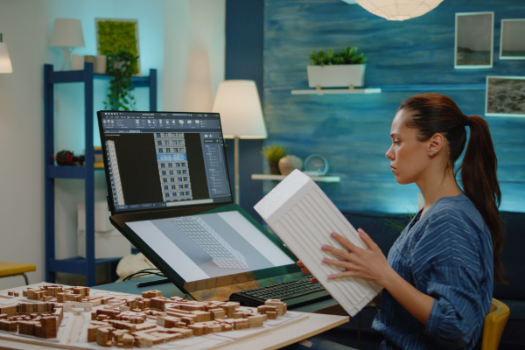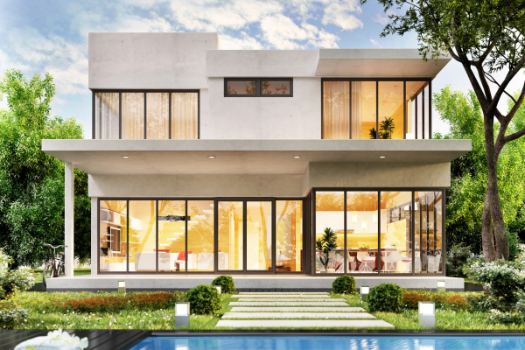.png)
The Architect’s Secret Weapon: How BIM Redefines the Design Process
Introduction: The Evolution of Architectural Design
Architectural design has evolved significantly over time. Traditionally, architects used hand-drawn blueprints and physical models to communicate their ideas. While these methods allowed for creativity, they were often error-prone and inefficient. Revising plans required starting over, and teams often struggled to coordinate effectively, leading to costly delays.
Building Information Modeling (BIM) has completely transformed the design process. Unlike traditional methods, BIM creates an intelligent, digital model that integrates all aspects of a project. This approach enhances collaboration, eliminates errors, and ensures every detail is accounted for before construction begins. Architects can now design with more precision and efficiency than ever before.
Today, BIM is the cornerstone of modern architecture. It not only saves time and money but also improves design accuracy. For architects, BIM has become a powerful tool to streamline processes, reduce risks, and create better buildings.
Understanding BIM: A Comprehensive Overview
Building Information Modeling (BIM) is a process that creates and manages digital representations of a building's physical and functional characteristics. It goes beyond simple drawings by integrating geometry, spatial relationships, and data into one comprehensive model. This approach gives architects, engineers, and contractors a clear and detailed view of every aspect of a project.

BIM serves as a central hub that connects all phases of a building’s lifecycle, from design and construction to maintenance and operation. It integrates structural, mechanical, electrical, and plumbing elements, creating a cohesive digital model. This unified system ensures that no detail is overlooked and allows for data-driven decisions throughout the project.
One of the most powerful aspects of BIM is its collaborative nature. By sharing a single digital model, architects, engineers, and stakeholders can communicate effectively and work together seamlessly. Updates made by one team are instantly reflected for others, reducing misunderstandings and minimizing errors. This level of coordination improves efficiency and ensures that everyone is aligned toward a shared goal.
BIM is more than a tool; it’s a transformative process that fosters collaboration, improves project outcomes, and ensures that designs are accurate and well-executed.
The Impact of BIM on the Design Process
BIM revolutionizes the design process by enabling the creation of detailed 3D models. These models provide architects with a clear and precise visualization of their designs, allowing them to refine details and improve accuracy before construction begins. Unlike traditional blueprints, BIM’s 3D capabilities make it easier to communicate ideas to clients and stakeholders, ensuring everyone shares the same vision for the project.

One of BIM’s most significant advantages is its ability to detect and resolve design conflicts early. The software identifies clashes between elements, such as structural beams intersecting with mechanical systems, during the planning phase. By addressing these issues before construction starts, architects can avoid costly delays and rework, saving both time and money. This proactive approach minimizes risk and ensures smoother project execution.
BIM also supports data-driven decision-making throughout the design process. The models integrate critical data, such as material properties, energy performance, and cost estimates, into a single platform. This enables architects to evaluate multiple design options based on real-world metrics and choose solutions that optimize efficiency and sustainability. With access to this information, architects can make informed decisions that improve project outcomes and align with client goals.
By enhancing visualization, preventing conflicts, and driving smarter decisions, BIM has become an essential tool for modern architects. It not only streamlines the design process but also ensures that projects are delivered with greater precision and success.
BIM and Architectural Visualization
BIM and architectural visualization work hand in hand to bring designs to life. By combining detailed 3D models with advanced visualization techniques, architects can create immersive experiences that go beyond traditional blueprints or static renderings. This synergy allows clients and stakeholders to truly see and understand the design before construction begins.
BIM enhances the creation of realistic renderings and virtual walkthroughs by integrating precise details into its models. Materials, textures, lighting, and spatial relationships are all represented accurately, resulting in visuals that are both detailed and lifelike. These renderings make client presentations more impactful, improving communication and making it easier to secure approvals. Clients can explore every angle of a project, ensuring their vision aligns with the final design.

The role of BIM extends further with its ability to support virtual reality (VR) and augmented reality (AR) experiences. These technologies allow users to step inside the design, exploring spaces as if they were already built. With VR, clients can virtually walk through rooms and evaluate layouts, while AR overlays design elements onto real-world environments. This level of immersion not only improves decision-making but also fosters greater confidence in the project’s direction.
BIM transforms visualization into an interactive, engaging experience, bridging the gap between concept and reality.
BIM in Construction and Beyond
BIM extends its advantages far beyond the design phase, playing a crucial role in construction. By serving as a centralized source of information, BIM improves project coordination and scheduling. All teams—architects, engineers, and contractors—work from the same digital model, ensuring everyone stays aligned. BIM’s ability to detect clashes reduces delays, while its scheduling features streamline workflows, keeping projects on track and within budget.

Sustainability is another area where BIM shines. Its energy analysis tools help architects and engineers evaluate energy consumption and explore more efficient designs. BIM also optimizes material usage, ensuring that resources are not wasted. These capabilities enable the creation of greener buildings while reducing costs, making sustainable practices more accessible and practical for construction teams.
Even after construction, BIM continues to add value through facility management. The digital model becomes a resource for maintaining and operating the building. It stores information on systems, materials, and layouts, making it easier to manage repairs or upgrades. Facility managers can access accurate data to plan maintenance schedules, reducing downtime and extending the building’s lifecycle.
From construction to long-term maintenance, BIM ensures efficiency, sustainability, and reliability at every stage of a building’s life.
The Future of BIM: Integrating AI and Advanced Technologies
The integration of Artificial Intelligence (AI) with BIM is shaping the future of architecture and construction. AI enhances BIM by automating complex tasks, analyzing large datasets, and generating insights that were once impossible to achieve manually. This combination allows architects to design faster and with greater precision.

One promising advancement is generative design, where AI creates multiple design options based on predefined criteria like cost, energy efficiency, and space utilization. Architects can explore these options and choose the most suitable one, saving time and resources. Predictive analytics is another game-changer, helping teams forecast potential issues, such as material shortages or structural weaknesses, before they occur.
AI also supports sustainability efforts by analyzing energy usage patterns and suggesting more efficient designs. By combining BIM with AI, architects and engineers can make informed decisions that prioritize both performance and environmental impact. This partnership enhances the overall quality and sustainability of projects.
BIM continues to evolve, becoming more intelligent and adaptive with each technological advancement. As AI and other tools integrate further, BIM will remain at the center of innovation, driving efficiency and transforming how buildings are designed, constructed, and managed.
Conclusion: Embracing BIM for a Transformed Design Landscape
BIM has transformed architectural design, offering unmatched accuracy, efficiency, and collaboration. It streamlines workflows, reduces errors, and enhances project outcomes, making it a cornerstone of modern architecture. For architects and firms, adopting BIM is crucial to remain competitive and meet industry demands.
To fully harness its potential, continuous learning and adaptation are essential. As technology evolves, so does BIM, introducing new tools and possibilities. Architects who embrace these advancements can drive innovation, deliver better projects, and stay ahead in a rapidly changing industry. BIM is not just a tool—it’s the future of architectural design.